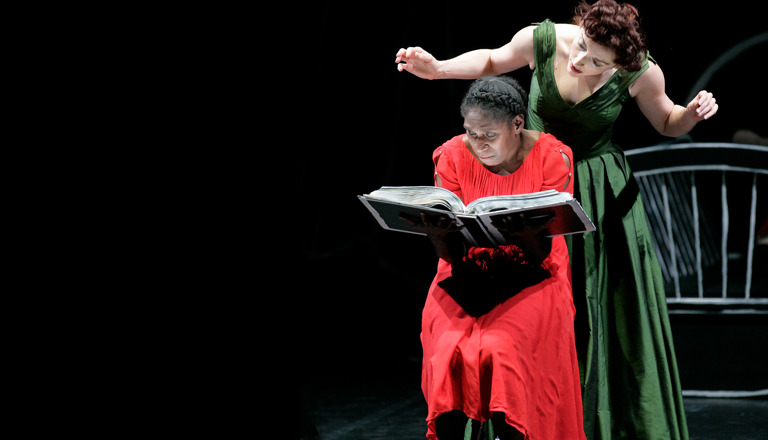Mathinna (2008)
Excerpts from Mathinna
FATHER, NURSERY, MOONSHINE.
Bangarra’s production of Mathinna shows how movement, imagery, design, music and sound all come together to present a narrative about social and cultural perceptions. By telling the story of one young Aboriginal girl’s life journey amid the social issues and hardships that emerge during the early days of Australian colonisation, through a contemporary theatre medium, the viewer connects not only to the events and actions, but the more nuanced impact and responses that those who actually lived the story might have experienced. The three excerpts in the clip explore some of these events and outcomes.
The first section in the clip is titled Father and is performed by one male dancer. The dancer is holding a large rock, and moving in a way that suggests great care and sacredness. The rock symbolises traditional knowledge, and the importance to guard and protect that knowledge in order that Aboriginal culture can be preserved into the future.
The second section in the clip is titled Nursery. Mathinna is trying to copy the movement (and the behaviour) of Lady Jane but everything she is trying to understand is mysterious and new – like shoes. The shoes make walking difficult and for Mathinna their purpose is not clear. The shoes also symbolise her struggle with ‘walking in the ways’ of another culture. During the dance, the music (sound score) includes the reciting of a letter written by Mathinna to her father Towterer.
Below is an excerpt from a letter in the book of fiction published in 2008 based on Mathinna’s story by Richard Flanagan titledWanting.
Dear Father
I am good little girl. I do love my father. I have got a doll and shift and a petticoat. I read books not birds. My father I thank thee for sleep. Come her to se mee my father. I thank thee for food. I have got sore feet and shoes and stockings and I am very glad….
Wanting, Flanagan, 2008. p 221
The third section is titled Moonshine. It illustrates the time in Mathinna’s life when she was re-located to her Aboriginal clan, who by this stage had been relocated to Oyster Cove. The community was suffering the impact of displacement, the loss of many family and clan members, and the destructive impact of alcohol.
HOW DO THE DANCES TELL THE STORY
In Father, the dancer moves in a very grounded manner. His movements are determined and slow, careful and calm. He achieves this quality of movement by focusing on how he transfers his weight and the concentrated and smooth isolation and coordination of separate parts of his body.
In Nursery, the dancer who represents Mathinna performs movements that reflect the type of body language that can be associated with innocence and fear. The movements are impulsive, but cautious – starting and stopping abruptly. The movements are small and the dancer’s focus is down.
The movement performed by the dancer who represents Lady Jane is broad and open to show the contrast with Mathinna’s movements. She dances in a way that is gracious but rigidly defined, her movements are purposeful and very measured to reflect the position of power and control that she holds as a member of the aristocracy.
In Moonshine, the female dancer who represents Mathinna, as well as 6 female dancers of the ensemble perform the section. They use a particular prop – a large over-sized bottle. The bottles represent both the impact of alcohol in the community and the sense of drowning as the desperate circumstances overtake Mathinna. The movements are slow and heavy as if the weight of the situation is overwhelming. There is no lightness in the movements and it is mostly orientated to the floor.

